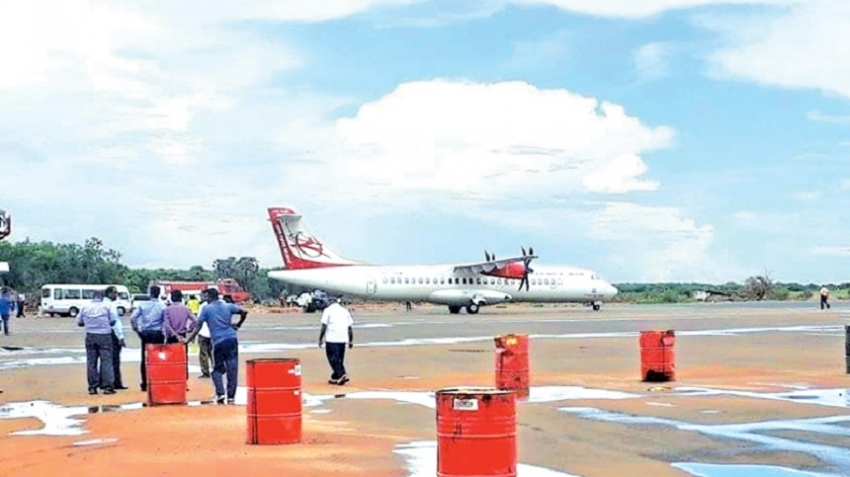Five decades ago, students and pilgrims to India could travel either by ferry from Thalaimannar to Rameswaram or by economy flights from Jaffna to Tiruchirappalli. While the ferry charge (Upper Class) was Rs 45 (US$ 9.5 at the then rate US$1= Rs 4.76), the economy fare to Tiruchirappalli was Rs 120.
This correspondent, as a student in India, travelled from Tiruchirappalli to Jaffna by Air Ceylon’s Dakota Aircraft in December 1974 and had the opportunity to have a brief conversation with a fellow traveller, Jaffna Mayor Alfred Duraiappah, very pleasant handsome man with shining black wavy hair. A few years later the shocking news of the assassination of this popular Sri Lanka Freedom Party Mayor Alfred Duraiappah by a militant Tamil group called Tamil New Tigers (TNT) headed by a Velvatithurai youth, Velupillai Prabhakaran. It was followed by another sad news about the closure of Thalaimannara-Rameswaram ferry service as well as commercial flights from Tiruchirappalli to Jaffna.
Jaffna International Airport in Palali
Much water flowed in the narrow Palk Strait between North Sri Lanka and South India since then and on October 17 we witnessed with jubilation the opening of Jaffna International Airport in Palali by President Maithripala Sirisena. Prime Minister Ranil Wickremesinghe and Minister Arjuna Ranatunga were also present on this occasion.
Jaffna Airport in Palali is now Sri Lanka’s third international airport –after Katunayake and Mattala – and it will have connections to four Indian cities. Smaller commercial planes will operate flights from Palali to Bengaluru, Kochi, Mumbai and Hyderabad.
However, there will not be flights to Chennai in the first phase. As the ferry service not in operation, Sri Lankans visiting South India have to travel by road to Katunayake and take a flight from Bandaranaike international airport to Chennai. Once the runway in Palali is expanded to accommodate wide-bodied aircraft, flights to Chennai could be commenced. Alliance Air, a subsidiary of Air India, will operate three flights a week and then add services depending on demand.
After upgrading Palali Airport, Sri Lanka plans to upgrade Ratmalana, the country’s first international airport which operated all the flights until the Katunayake International Airport was built, and the Batticaloa Airport in the East, taking the number of international airports in the country to five.
Development of the Northern Province was underscored as a top priority for the Government’s development agenda and the Government believes an international airport in the peninsula would boost the region’s economy significantly.
The airport will be developed in two stages: expansions of the runway and related facilities will be completed during the first phase, while permanent terminal buildings will be constructed during the second phase, once the airport attracts a significant amount of air traffic.
The extent of the Palaly runway will be expanded to 3,500 metres, and it will have the capability to handle large passenger aircraft such as the Airbus A320 and A321.
Once completed, the strategically-located Jaffna International Airport will have the capacity to handle direct commercial flights to countries like India, Australia, China, Japan, Middle East nations, and several European countries.
The Jaffna International Airport is located in Palali, 16 km away from the Northern capital city, Jaffna. The airport was originally built by the Royal Air Force during World War II and later served as the country’s second international airport before being taken over by the Sri Lanka Air Force. During World War II the British Royal Air Force stationed several RAF squadrons and air-sea rescue units at Palali airfield. The airfield was abandoned after the war and taken over by the Department of Civil Aviation. Subsequently, Air Ceylon was set up and the inaugural flight by Air Ceylon was on December 10, 1947 from Ratmalana Airport to Madras via Jaffna.
After independence, the airport provided domestic flights to Colombo and international flights to south India. The growth of Tamil militancy put an end to civilian flights at the Jaffna airport in Palali.
Main lifeline in the North
Jaffna Commander Major General Ruwan Wanigasuriya said that during the conflict, the Palali Airport served as the main lifeline in the North. A large number of soldiers travel to this airbase. When the area south of Jaffna was under the control of LTTE, the Palali was used for all the supplies from military material to food and medicines. A Sri Lanka Air Force detachment moved onto the site in 1976. The site became an Air Field Unit in January 1982. The airport served as a major facility for the Sri Lankan military during the conflict. During the early 1990s, the airport and surrounding areas were declared a High-Security Zone and all the residents were evicted to an alternative residence in the Peninsula. After the Valikamam was recaptured by the Sri Lankan military in 1995 the airport served as a vital link to the rest of the country as the land route was controlled by the LTTE.
In 1996 Lion Air started operating flights for civilians between Jaffna and Colombo. Monara Airlines started flights on the same route in March 1998. Monara suspended its services on September 16, 1998 after receiving threats from the LTTE for carrying military personnel.
In June 2002 ExpoAir started operating flights for civilians between Jaffna and Colombo, which was later suspended.
After the end of the conflict in 2009, the Palali Airport was opened for domestic civilian flights and a decade later the Palali Airport, renamed as Jaffna International Airport, the Northern Province gets reconnection to South India and, eventually to the world at large.
Furthermore, Gen Wanigasuriya said that Jaffna International Airport would have international and domestic terminals for civilian flights. Sri Lanka Air Force will continue to operate its flights. Gen Wanigasuriya added that the new international airport would be a tremendous boost to reconciliation efforts as well as for the tourism industry in Sri Lanka.




















